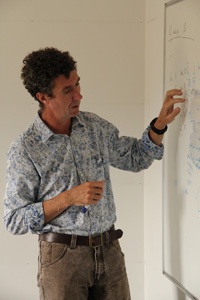Ecological scaffolding and the evolution of multicellularity

Paul RAINEY
Department of Microbial Population Biology, Max Planck Institute for Evolutionary Biology, Plön, Germany; Laboratoire de Génétique de l’Evolution, Ecole Supérieure de Physique et de Chimie Industrielles de la Ville de Paris, Paris, France & The New Zealand Institute for Advanced Study, Massey University, Auckland, New Zealand. paulbrainey@gmail.com
(Seminar in English)
Life is hierarchically structured, with replicating entities nested within higher order self-replicating structures. Take, for example, multicellular life: the multicellular entity replicates, as do the cells that comprise the organism. Inside cells are mitochondria that also have capacity for autonomous replication; the same is true of chromosomes within the nucleus, and of genes that comprise chromosomes. Such hierarchical structure reflects a series of major evolutionary transitions in which lower order self-replicating entities have been subsumed within higher order structures. Typically this involves the lower level entity “giving up its right to autonomous replication” and with this “sacrifice” comes enslavement to the “needs” of the higher-order “corporate body”. Posed in these terms it is difficult to see how evolutionary transitions unfold; how selection might shift levels and why life is hierarchically structured. Necessary for progress is clarity concerning what needs to be explained. I will argue that this is the evolution of individuality — the evolution of properties of entities (variation, reproduction and heredity) that ensure participation in the process of evolution by natural selection. There has been a tendency to assume these properties as pre-existing, but they are not: they are derived and require evolutionary explanation. Pressing to the heart of the problem, the challenge is to explain how Darwinian properties emerge from non-Darwinian entities by non-Darwinian means. This challenge permeates each evolutionary transition including the emergence of life from non-life. I will argue that solutions to this seemingly unsolvable problem arise once we consider ecology. Following presentation of theoretical work, I will recount an experiment that explores central ideas.
Contact du Comité SEEM: seem@services.cnrs.fr. Contact du Labex CEMEB: cemeb-gestion@umontpellier.fr


